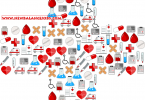
So, you’ve decided to conquer the academic world by writing an amazing research paper – fantastic! You’re probably wondering what it takes to make your paper truly stand out and captivate readers, right?
Fear not, for this blog post is ready to guide you through the essential components of a top-notch research paper. By the end of our journey together, you’ll have a solid blueprint to create an engaging and informative masterpiece that’ll impress even the toughest critics. Let’s dive in!
1. Picking Your Perfect Research Question
Picking the perfect research question is crucial, and it depends on the context of your paper. After all, the foundation of any brilliant research lies in a thought-provoking question that sparks curiosity.
For a scientific study, a well-formulated hypothesis sets the stage for clear objectives and measurable outcomes. On the other hand, philosophical inquiries invite deeper exploration into complex ideas.
For example, in a scientific study about nutrition and heart health, your hypothesis could be, “Does consuming a plant-based diet lead to reduced rates of heart disease compared to diets high in animal protein?”
Meanwhile, a philosophy paper might ask, “To what extent does personal identity persist over time and through changes in consciousness?“
These examples illustrate how you can craft specific and engaging research questions tailored to your field. To gather more tips on honing your research question and kick-starting your academic treasure hunt, check out this guide on how to write a research paper like a pro.
2. Diving Deep into the Literature Pool
Now that you have your shiny research question in hand, it’s time to get your feet wet and wade through the existing literature. Don’t underestimate this step – it’s essential for grounding your research within the context of what’s already been explored, debated, and discovered.
Think of literature reviews as a treasure map: they help you navigate through previous findings, identify gaps in knowledge, and highlight recent breakthroughs relevant to your research. Also, paying close attention to related studies can inspire fresh perspectives or innovative approaches you hadn’t considered before.
When reviewing the literature, tackle different types of sources like landmark texts, scholarly articles, and experts’ opinions to paint a comprehensive picture of the field. Ensure that you critically evaluate and compare their contributions, so your readers understand how your work fits within this context.
Valuable Resources for Research:
- Google Scholar (scholar.google.com): A user-friendly search engine that indexes scholarly articles across disciplines and provides access to many open-access articles.
- JSTOR (www.jstor.org): An extensive digital library comprising academic journals, books, and primary sources in multiple fields.
- PubMed (pubmed.ncbi.nlm.nih.gov): A free database specializing in life sciences and biomedical research papers.
- PhilArchive (philarchive.org): A comprehensive open-access online archive of academic philosophy papers, offering full-text access to thousands of works from top-tier journals and respected authors in the field.
- ResearchGate (www.researchgate.net): A social networking site for researchers to share publications and connect with fellow professionals within their field.
3. Choosing the Right Tools: Your Methodology Matters
Alright, with a captivating research question and a solid grasp of the literature landscape, it’s time to pick your methodology. Your choice of research methods can make or break your study, so selecting the right approach is essential.
Your methodology should be tailored to fit both your research question and your chosen field. Depending on the nature of your study, you could opt for quantitative methods like surveys or experiments, qualitative techniques such as interviews or observations, or even a mixed-methods approach that combines both.
Here’s a list of popular research tools and their potential applications across different types of studies and disciplines:
- Statistical software (e.g., SPSS, R, SAS): Applicable in various fields like economics, psychology, or public health, these tools allow you to run statistical analyses on large quantitative datasets.
- Geographic Information System (GIS): Great for studies involving spatial data or geography, GIS software such as QGIS or ArcGIS can help you visualize and analyze geographical information.
- Online survey platforms (e.g., SurveyMonkey, Google Forms): Useful for collecting opinion-based data from participants in any field, particularly when targeting a specific audience.
- Qualitative analysis software (e.g., NVivo, Atlas.ti): Ideal for analyzing text or audio data from interviews or case studies in fields like sociology, anthropology, or communication research.
- Coding languages (Python, MATLAB): For computer science research or studies requiring advanced computational algorithms and simulations.
Remember that the best tools will depend on your specific study objectives and the nature of your data collection. It is crucial to choose appropriate techniques that align with your goals while also ensuring reliability and accuracy throughout the entire process.
Bringing It Home: Conclusions and Real-World Impact
As we reach the end of our thrilling expedition, it’s time to tie everything together with a compelling conclusion. Your conclusion serves as a powerful finale that drives home the key findings of your research and highlights their significance in the real world.
Start by summarizing your main insights and how they connect to your initial research question. Then, discuss the implications of your findings within the broader context of related studies, shedding light on how your unique contributions enhance understanding in this particular field.
Don’t be shy about showcasing potential real-world applications or suggesting new lines of inquiry inspired by your work. Remember, your conclusion should provoke thought, stimulate conversation, and encourage further exploration among both experts and novices alike.






